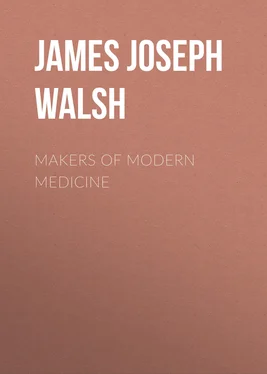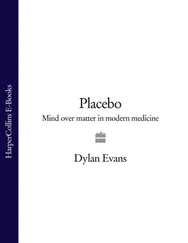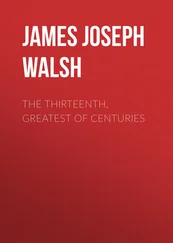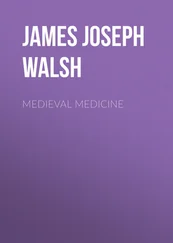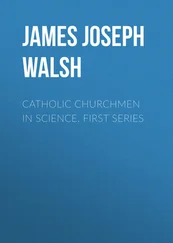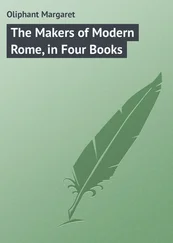James Walsh - Makers of Modern Medicine
Здесь есть возможность читать онлайн «James Walsh - Makers of Modern Medicine» — ознакомительный отрывок электронной книги совершенно бесплатно, а после прочтения отрывка купить полную версию. В некоторых случаях можно слушать аудио, скачать через торрент в формате fb2 и присутствует краткое содержание. Жанр: foreign_prose, Медицина, foreign_antique, на английском языке. Описание произведения, (предисловие) а так же отзывы посетителей доступны на портале библиотеки ЛибКат.
- Название:Makers of Modern Medicine
- Автор:
- Жанр:
- Год:неизвестен
- ISBN:нет данных
- Рейтинг книги:3 / 5. Голосов: 1
-
Избранное:Добавить в избранное
- Отзывы:
-
Ваша оценка:
- 60
- 1
- 2
- 3
- 4
- 5
Makers of Modern Medicine: краткое содержание, описание и аннотация
Предлагаем к чтению аннотацию, описание, краткое содержание или предисловие (зависит от того, что написал сам автор книги «Makers of Modern Medicine»). Если вы не нашли необходимую информацию о книге — напишите в комментариях, мы постараемся отыскать её.
Makers of Modern Medicine — читать онлайн ознакомительный отрывок
Ниже представлен текст книги, разбитый по страницам. Система сохранения места последней прочитанной страницы, позволяет с удобством читать онлайн бесплатно книгу «Makers of Modern Medicine», без необходимости каждый раз заново искать на чём Вы остановились. Поставьте закладку, и сможете в любой момент перейти на страницу, на которой закончили чтение.
Интервал:
Закладка:
Further examples might well be cited, but they will be met with in the course of this book. The history of most of the sciences is like medicine in this respect, and it is to young men that the great ground-breaking ideas come. How true this is in biology can be noted even from the lives of the physician-biologists that are included in this volume. Theodore Schwann, the father of the cell doctrine, did all the work for which he deserves the name of founder of modern biology when he was scarcely more than thirty. Part of the best of it was accomplished before he was twenty-five. Claude Bernard had shown the precious metal of his originality before he was far on in his twenties. Pasteur, the most original genius of them all, began his work when he was scarcely more than a boy, and though every five years of a long life was filled with original observations of the most precious kind, his genius had received the bent which it was to follow from the successful accomplishment of observations during his third and fourth decades.
In these modern days, when the education of the young man for medicine is not supposed to be finished until he is nearly thirty, it is easy to understand that perhaps the precious years in which originality might manifest itself are already past before he gets out of the swaddling clothes of enforced instruction from others. As has been very well said, it is possible to smother whatever of the investigating spirit and original initiative there may be in a young man by attempting to teach him too much of what the present generation knows. Unfortunately, it happens only too often even in this wise generation of ours that it is not so much the ignorance of mankind that makes them ridiculous as the knowing so many things that are not so. The number of things that the young man has to learn and that are taught him, often with the assurance that they are almost gospel truth in medicine, and yet that he finds before he has been long out of school or indeed sometimes before he leaves school, to be at best opinions, is entirely too great. The saving grace for the correction of this constantly recurring fault in education is undoubtedly a knowledge of the development of medicine in the past and a recognition of the fact that the accepted truth of any one generation proves after all often enough to be only apparent.
After the false impression that it is to older men we owe progress in medicine, perhaps the most universally accepted apparent truth is that the investigating spirit is communicable, and that the pupils of a great master may be expected to carry on his work and add almost as much as he has done to the great body of medical knowledge during the generation immediately following his work. It would naturally be expected, for instance, that Morgagni having laid the foundations of modern pathology and connected pathological observation with clinical observation the great development in modern diagnosis would have come down in Italy. This was not true, however. The next great step connecting bedside observations with postmortem appearances was made by Auenbrugger in Vienna in distant Austria. Auenbrugger's work having been successfully accomplished it might reasonably be supposed that he himself or some of those who had seen his successful diagnosis of thoracic conditions by percussion would take the next step and discover auscultation. This, however, did not happen in Germany, but in France. It is true that Laennec's work was done under the influence of Corvisart, who revived Auenbrugger's work and gave it to the world once more, and that in a way, therefore, Laennec may be considered an indirect pupil of Auenbrugger; but the fact stands that the two discoveries of percussion and auscultation were made at an interval of nearly fifty years and at a distance of more than a thousand miles from each other.
On the other hand, Laennec having solved the wonderful mystery of the significance of the sounds within the chest as far as they concern pulmonary diseases might have been expected to do as much also for heart disease. Even genius, however, is able it seems to take only one step into the unknown. Auenbrugger did not discover auscultation, though it apparently lay so near at hand. Laennec did not solve the riddle of heart murmurs, though for most of us they do not present any more difficulty than the wonderfully successful recognition of the significance of râles of various kinds in which Laennec never failed. The problem of heart diagnosis was to be solved by Corrigan and the Irish school of medicine hundreds of miles away, though they were doing their work about the same time that Laennec was making his observations in Paris. Curiously enough just during the same decade Richard Bright, in England, was studying out the problem of kidney disease, and, as a young man, teaching the world nearly as much about it as it has ever learned, though, in the seventy-five years that have passed since, so much of investigation has been devoted to the subject.
No one nation can claim the palm of superiority in the matter of original investigation. The spirit of genius breathes where it will, and unfortunately it is incommunicable. Students may think they absorb all that the master has to give them, and that they are ready to go on with his work where he left it. They do actually seem to their own generation to make distinct progress in medicine. When the situation is analyzed fifty or a hundred years afterward, however, it is found that only the master's work counts, and that much of what seems to be advance was only a skirmishing here and there along the lines laid down by him, but without any material progress for true science.
This same peculiarity is manifest, also, not only in the history of sciences allied to medicine, but in that of all the physical sciences. A very striking example is to be found in the story of the rise of electrical science, which took place almost at the same period as that which saw the rise of clinical medicine. Origins in electricity date from Franklin's work here in America and Galvani and Volta's observations in Italy. It might quite naturally have been expected that the further progress of electrical science would come in either of these countries. The next great discoveries, however, were separated by long distances and a considerable interval of time. After Volta came the demonstration by Oersted, in Denmark, of the identity of magnetism with electricity. It was not in Denmark, however, that the problems connected with this principle were worked out, but by Ampere in France. In the mean time, Cavendish and Faraday, working quite independently of their Continental colleagues, were making significant strides in electricity in England.
When the problem of the resistance to the passage of electricity in a conductor was to be studied, another nation supplied the man for the opportunity. Ohm had never been in contact with any of these great contemporaries and did his work entirely by himself. It is a curious confirmation of what we have stated with regard to the young man in medicine and the making of great discoveries that practically all these founders in electricity were under thirty-five when their best original work was accomplished.
From a series of biographies of great medical discoverers, certain salient traits stand out so as to attract attention even from the cursory reader. The essence of significant work in medicine consists of observation, not theory. It has always been the custom to theorize much and unfortunately to observe but little. Long ago John Ruskin said that the hardest thing in the world for a man to do is to see something and to tell it simply as he saw it. Certainly this has been true in medicine. The men who have had eyes, and have used them, have impressed their names upon the history of progressive scientific advance. The theorists have never contributed anything worth while to the body of medical truth.
Читать дальшеИнтервал:
Закладка:
Похожие книги на «Makers of Modern Medicine»
Представляем Вашему вниманию похожие книги на «Makers of Modern Medicine» списком для выбора. Мы отобрали схожую по названию и смыслу литературу в надежде предоставить читателям больше вариантов отыскать новые, интересные, ещё непрочитанные произведения.
Обсуждение, отзывы о книге «Makers of Modern Medicine» и просто собственные мнения читателей. Оставьте ваши комментарии, напишите, что Вы думаете о произведении, его смысле или главных героях. Укажите что конкретно понравилось, а что нет, и почему Вы так считаете.
